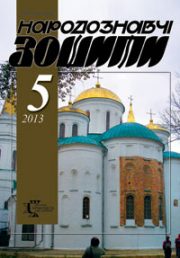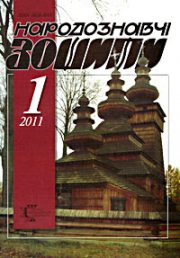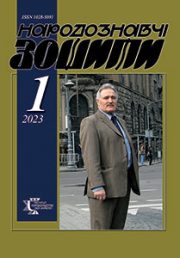The Ethnology Notebooks. 2021. № 5 (161), 1201—1217
UDK 271.2-523.47(477. 83-22)”15″
DOI https://doi.org/10.15407/nz2021.05.1201
HELYTOVYCH Maria
- ORCID ID: https://orcid.org/0000-0001-5839-9585
- Candidate of Arts, Associate Professor
- Head of the department of ancient Ukrainian art
- Andrey Sheptytskyi National Museum in Lviv
- Svobody avenue, 20, 79000, Lviv, Ukraine
- Contacts: e-mail: helytovychm@yahoo.com
Abstract. In the article for the first time is made an attempt to consider as a whole the big complex of stylistically related icons of the second half of the XVI century, which is associated with works of one of the few painters of Ukrainian icon painting of that time. His name is recorded on the monument — master Dmytriy. His «Savior Pantocrator» from 1565 belongs to the most famous masterpieces of Ukrainian art. There is analyzed artistic and iconographic features of the eleven famous works of this icon painter, which come from three churches in the Valley of Ivano-Frankivsk region.
Creativity of the Dimitri in the broader context of the Ukrainian iconography of the second half of the XVI century is analyzed for the first time. New research shows that his activities have had an impact on important processes that took place in the Western Ukrainian sacred art of the last third of the XVI century. Painting and figurative features of Dmytriys works which distinguish them from the general background of those times Ukrainian sacred painting are indicated.
It is considered a number of iconostasis ensembles and icon complexes in which similar figurative, stylistic and iconographic characteristics are traced.
Such is the iconostasis from the church of the Cathedral of the Blessed Virgin in the village Lybokhora. It belongs to the three oldest fully preserved three-tiered iconostasis complexes of the XVI century. The proximity of places of origin of monuments — town Dolyna and village Lybokhora is an additional argument for their belonging to one painting environment. These sights also include two iconostasis fragments from the churches of St. Nicholas in Kamyanka Buzka and the Holy Spirit in Rohatyn.
Among the icons of other stylistic groups and trends that existed in Western Ukrainian iconography of that period, they are most distinguished by the type and color, technical and technological characteristics. An individual monuments of similar style are also considered. Based on the systematization of monuments, there is reason to believe that the master Dmytriy is one of the brightest Ukrainian icon painters of the second half of the 16th century, and the most expressive artist of a «monumental approach» among the painters working in a similar style. Icons of this stylistic direction are an essential part of the total volume of Western Ukrainian icon painting of this period, giving it a lot of dimension in figurative, iconographic, coloristic aspects. There is expressed an assumption about the influence of the master Dmytriy on the development of an entire stylistic line in Western Ukrainian painting of the second half of the 16th century, in which Balkan specimens found a clear echo.
Keywords: research, master, icon, stylistics, tradition, se cond half of the 16th century.
Received 14.09.2021
REFERENCES
- Putsko, V. (1998). Icon of St. Mykola Myletsky by Suceava painter Hryhoriy Bosykovych. Notes of the Shevchenko Scientific Society (Vol. ССХХХVІ, pp. 373—397). Lviv [in Ukrainian].
- Sydor, O. (2000). Icons of masters Olexiy and Dmytriy in the collection of the National museum in Lviv. (From the materials to the consolidated catalog of NML collections). Chronicle of the National Museum in Lviv (Issue 1 (6), pp. 89—152). Lviv: National Museum of Lviv [in Ukrainian].
- Skop, L. (2011). Master of miniatures of the Peresopnytsia Gospel — Fedusko, painter from Sambor. Drohobych: Kolo [in Ukrainian].
- Helytovych, M. (2012). Iconostasis of the last third of the XVI century from the church of the Cathedral of the Blessed Virgin in Lybohora. Chronicle of the National Museum in Lviv named after Andrei Sheptytsky. Lviv: National Museum in Lviv (Issue 9 (14), pp. 34—61) [in Ukrainian].
- Helytovych, M. (2007). A set of icons of the 1580s from the church of St. Mykola in Kamianka Buska. Being in art: a collection of scientific papers and materials on honoring Stepan Kostyuk on the occasion of the 80th anniversary (Pp. 157—167). Lviv [in Ukrainian].
- Melnyk, I., & Helytovych, M. (2007). Iconostasis of the late XVI century from the Church of the Holy Spirit in Rohatyn. Attribution problems. Bulletin of the Lviv branch of the National Research and Restoration Center of Ukraine (Pp. 15—19). Lviv [in Ukrainian].
- Sventsitska, V.I. (1967). Painting of the XIV—XVI centuries. History of Ukrainian art (Vol. 2, pp. 208—274). Kyiv [in Ukrainian].
- Ovsiychuk, V. (1996). Ukrainian painting of the X—XVIII centuries. Color problems. Lviv: Institute of Ethnology of the National Academy of Sciences of Ukraine [in Ukrainian].
- Patriarch, Dmytriy (Yarema). (2017). Icon painting of Western Ukraine of XVI — early XVII century. Lviv: Drukarski kunshty [in Ukrainian].
- Helytovych, M. (2008). Icons from Dolyna — valuable monuments of Ukrainian art. Collection of scientific and theoretical articles on the materials of the round table «Problems of museification in Boykivshchyna» and scientific and practical conference «Archaeological and sacred trails of Dolyna» (Issue 2, pp. 47—56). Dolyna [in Ukrainian].
- Sventsitsky, I. (1928). Icon painting of Galician Ukraine XV—XVI centuries. Lviv [in Ukrainian].
- Milyaeva, L. with the participation of Helytovych, M. (2007). Ukrainian icon of the XI—XVIII centuries. Kyiv [in Ukrainian].
- Biskupski, R. (1982). Selected icon painting workshops of the Halych school of XV and XVI century. Folia Historiae Artium (Vol. XVII, pp. 25—42). Krakow [from Polish].
- Sventsitska, V.I., & Otkovych, V.P. (2 eds.). (1991). Ukrainian folk painting of the XIII—XX centuries: the world through the eyes of the folk artists: album. Kyiv: Art [in Ukrainian].
- Helytovych, M., & Skrypnyk, H. (Ed.). (2017). Iconostasis of the Church of the Intercession of the Blessed Virgin of the middle of XVI century from the village Polyana, Lviv region: an attempt at reconstruction. Art Studies: Architecture. Fine, decorative and applied art, 4, 31—43 [in Ukrainian].
- Helytovych, M. (2019). Iconostasis of the Church of the Assumption of the Blessed Virgin of the Nakonechne village — the most complete iconostasis ensemble of the XVI century. Herald of the Lviv National Academy of Arts (Issue 39, pp. 73—88). Lviv: LNAM [in Ukrainian].
- Slobodyan, V. (2003). Churches of Turka district. Lviv [in Ukrainian].
- Nikolesku, K. (1961). Old Romanian Icons. Bucharest [in Romanian].
- Yurkevych, Yu. (Ed.). (2012). The royal gates of Ukrainian iconostasis: an album. Lviv: Institute of Collecting of Ukrainian Art Monuments at NTSh [in Ukrainian].
- Vuytsyk, V. (2004). Church of Kamyanka-Buzka. Bulletin of the Institute «Ukrzahidproektrestavratsiya», 14, 190—191 [in Ukrainian].
- Umantsev, F.S. (1967). Painting of the end of the 16th — first half of the 17th century. History of Ukrainian art (Vol. 2, pp. 275—318). Kyiv [in Ukrainian].
- Konstantynovich, J. (1930). Ikonostasis in the 17th century within the borders of the former dioceses: Peremyshl, Lviv, Belz and Kholm. Sample characteristics (Part II, pp. 9—12). Sanok [in Polish].
- Helytovych, M. (2004). Little-known monuments of Ukrainian icon painting of XV—XVI century (from the collection of the National Museum in Lviv). Western Ukrainian church art. Proceedings of the International Scientific Conference at 17—18 April 2004 (Pp. 57—132). Lancut [in Ukrainian].
- Sventsitsky-Sviatitsky, I. (1929). Icons of Galician Ukraine of the XV—XVI centuries. Lviv [in Ukrainian].
- Fedak, M. (2012). Iconographic features of the icon «Doomsday» (last quarter of the XVI century) from Radelych. Chronicle of the Andrey Sheptytsky National Museum in Lviv (Issue 9 (14), pp. 62—67). Lviv [in Ukrainian].
- Melnyk, V.I. (Ed.). (1991). Church of the Holy Spirit in Rohatyn: Album.Kyiv: Art [in Ukrainian].
- Logvyn, H., Milyaeva, L., & Sventsitska, V. (1976). Ukrainian medieval painting: album. Kyiv: Art [in Ukrainian].
- Mokriy, V. (1997). Two works by Hryhoriy Bosykovych in the Lviv Art Gallery. Volyn Icon: Questions of the History of Research and Restoration. Reports and materials of the IV scientific conference (Pp. 94—98). Lutsk [in Ukrainian].
- (1999). Masterpieces of Ukrainian icon painting of the XIX—XX centuries: album. Kyiv: Art [in Ukrainian].
- Kozak, A. (2006). Restoration of the icon «Christ Pantocrator» 1592 from the village Tseptsevychi from the collection of the Rivne Museum of Local Lore. Bulletin. Information issue. National Research and Restoration center of Ukraine. Lviv branch (Issue 8, pp. 138—140) [in Ukrainian].
- Dr. Sebastian, Dmytrukh. (2008). Ukrainian sacred art from the collection «Studion». In the collection of the Andrey Sheptytsky National Museum in Lviv (Part II). Lviv: Sribne slovo [in Ukrainian].






